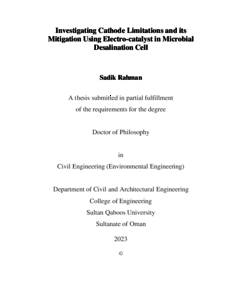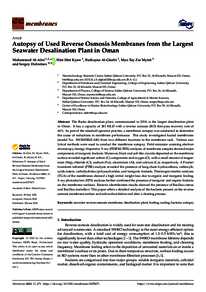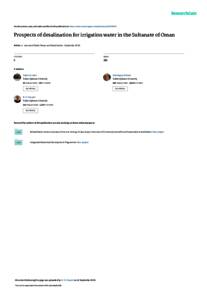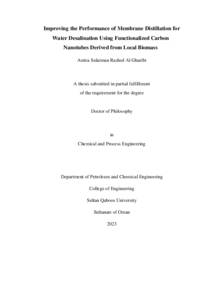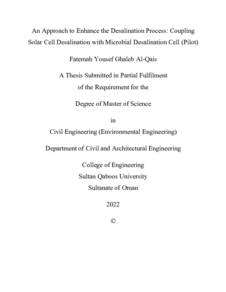Document
Investigating cathode limitations and its mitigation using electro-catalyst in microbial desalination cell.
Other titles
دراسة تحديات وحلول الكاثود في خلية التحلية الميكروبية باستخدام المحفزات الكهربائية
Publisher
Sultan Qaboos University.
Gregorian
2023
Language
English
English abstract
Globally seawater desalination depends on expensive and energy-intensive processes
with high GHG emissions. Recently microbial desalination cell (MDC) has been
explored as a promising desalination technique that uses bioenergy to operate as a low
emission method while requiring little to no energy. MDC is fundamentally a bio electrochemical system (BES) that extracts bio-energy from the biological oxidation of
pollutants to carry out desalination using beneficial bacteria. In a typical MDC, the
anodic and cathodic processes govern the success of the desalination performance.
However, the desalination in MDC is mainly restricted by cathodic limitations. The
limitation in cathode accounts for more than 80% of the total over potential, which is the
sum of the resistances contributed by the cathode, electron acceptors, and side reactions.
Hence a thorough understanding of cathodic limitations from the resistance standpoint is
required to guide the cathodic improvement for efficient MDC operation. Therefore this
doctoral thesis comprehensively reviewed the literatures to identify the engineering and
operational challenges in MDC and their possible solution from a cathodic limitation
standpoint. Promising catalysts were reviewed and proposed for cathodic improvement.
In order to understand the cathodic limitation, this research aimed (i) to understand the
external and internal resistance as cathodic limiting factors in two separate three chamber microbial desalination cell (MDC) configurations, i.e., (a) Air pumped
catholyte MDC and (b) Air cathode MDC, (ii) to investigate the effect of external and
internal resistance, and substrate on improving desalination in a circular air cathode
MDC using real leachate mixed municipal wastewater as anodic electrolyte. To mitigate
the cathodic limitations, this research (iii) synthesized and applied the reduced graphene
oxide (rGO) and polymerized aniline (PANI) composite as a promising electro-catalyst
on stainless steel mesh for cathodic improvements in MDC and (iv) synthesized and
applied the bismuth oxychloride (BiOCl) and graphitic carbon nitride (gCN) composite
as electro-catalyst on stainless steel mesh for cathodic improvements in MDC.
The first study investigated the impact of external resistance (Rext) on MDC
performances having two different internal resistances (Rint) by changing the MDC
cathode configurations. The results showed that the effect of Rext on the desalination rate
(2.52 mg/h) was quite low when Rint of MDC was high (200Ω). However, operating
MDC with low Rint (67Ω) significantly improved the desalination rate (9.85 mg/h) and
current generation. When MDC was operated with low Rint the effect of variable Rext on
desalination and current generation was noticeable. The MDC with low Rint was
investigated to find the optimal range of Rext for efficient MDC performance. The
optimal range was found as Rext << Rint, Rext < Rint, Rext ≈ Rint (ranging from 1-69 Ω) to
achieve the highest desalination rates (10.41-8.59 mg/h). The findings suggested that in
order to achieve the best desalination rate, MDC should be first manufactured with
minimum internal resistance. Additionally, MDC with low internal resistance are only
able to display an optimal range of external resistances that can significantly affect
performance within that range.
The first study used synthetic wastewater for investigation. It was important to know the
impact of resistances (external and internal) in real wastewater context. The second
investigation of cathodic limitation used real leachate mixed municipal wastewater in a
circular air cathode MDC to do pre-treatment while investigating the effect of external
and internal resistance, and substrate on improving desalination and power generation.
This circular air cathode MDC had very low internal resistance. The measured bio electrochemical performances for MDC-1 (operated with 1 Ω Rext) showed a higher
desalination rate (DR) (35.71 mg/h) and NH3-N removal (36%) with low removal of
COD (28%) than MDC-100 (operated with 100 Ω Rext). While MDC-100 showed lower
DR (17.98 mg/h) and NH3-N removal (10%) with higher removal of COD (78.26%).
The results revealed that Rext could regulate the pollutants (organics, NH3-N) removal
and desalination efficiency. Hence, adjustment of the external resistance at the outer
circuit can significantly influence the electrochemical performance which was
corroborated bt the first study. The lack of soluble organics could also result in
significant discrepancies in bio-electrochemical performance. MDC-100 showed four
times higher energy output (5.63 W·m-3
) compared to MDC-1 (1.39 W·m-3
), while
MDC-1 showed five times higher columbic efficiency (29.3%) compared to MDC-100
(5.52%).
After the cathodic limitation study, the thesis concentrated on investigations to improve
cathodic limitation using new type of cathode catalysts. The third research studied the
cathodic improvement by PANI-rGO electro-catalyst composite. The study synthesized
the composite at four different concentrations of rGO and fixed concentration of PANI
electro-deposited layer by layer on stainless steel mesh (SSM). Microstructure and
morphology analysis showed good composite between PANI and rGO with layered
nano-fibrous structure. The electron transfer was improved by increasing concentration
of rGO layer. The best performing composite (PANI-rGO1.0-SSM) was applied in MDC
cathodic improvement with variable loading of rGO1.0 by changing deposition cycles.
The result showed promising improvement by PANI-rGO1.0 electro-catalyst with 30
cycles of rGO1.0 deposition. The desalination rate was improved by 40.5% compared to
control plain SSM. The internal resistance was also significantly reduced to 96% than
plain SSM. This study showed the rGO-PANI composite with high performing loading
rate improved the MDC performance by decreasing the internal resistance and high
electro-catalytic activity. Cost analysis showed layer by layer electro-deposition of
PANI-rGO1.0 on SSM cathode is an advantageous and low cost binder free coating
method compared to Platinum coated cathode.
The last research of the thesis synthesized the BiOCl/g-CN electro-catalyst composite
and investigated as cathode catalyst for MDC desalination improvement. Five differnet
composites werer prepared by mutually increasing ratio of both the materials. The XRD
and FT-IR result showed an efficient composite formation between BiOCl and g-CN.
The ratio of BiOCl and g-CN has proportionally increased or decreased the characteristic
peaks. All the composites showed improved redox performance compared to plain SSM
in CV characterization. The two best-performing ratios and loading rates were C3
(50mg/cm2
): BiOCl/g-CN (50:50) and C1(20 mg/cm2
): BiOCl/g-CN (100:0) which were
coated to use as cathode in MDC. C3 (50 loading) showed 49% and C1 (20 loading)
showed 42% improvement in desalination rate compared to control. C3(50 loading) and
C1(20 loading) effectively reduced the internal resistance of MDC by 50% and 13%
respectively. Cost analysis showed low preparation expense (14%) for this catalyst
coated cathode from this earth-abundant Bi-based catalyst and promising g-CN using
brush coating. This study concluded that these green BiOCl and g-CN can be
composited effectively to use as a sustainable electro-catalyst for stainless steel mesh
cathode and to improve the desalination and current generation performance in MDC.
This thesis concluded that fabricating an MDC with low internal resistance was critical
prior to adjusting the external resistance. Low Rint MDC can effectively control
treatment, desalination and energy production while using the real wastewater like
leachate mixed with municipal wastewater as anolyte. Both PANI-rGO1.0 and BiOCl/g CN cathode electro-catalysts were effective to improve desalination performance and
could be used as a alternative to expensive electrocatalysts like platinum. Future research
should focus on thin layer electro-deposition composite preparation to optimize the
loading rates of rGO to get improved reaction kinetics in MDC cathode. For BiOCl/g CN, the thickness and distribution of catalyst loading needs optimization. Both the
composites should be investigated for air-cathode preparation to effectively use air available oxygen in the electrolyte for better oxygen reduction reaction.
Member of
Resource URL
Arabic abstract
تعتمد تحلية مياه البحر على الصعيد العالمي على عمليات مكلفة ومستنفذة للطاقة مع انبعاثات غازات مضرة للبيئة. تم استكشاف مؤخرا خلية تحلية المياه الميكروبية باعتبارها تقنية واعدة لتحلية المياه التي تستخدم الطاقة الحيوية وأيضا تتطلب طاقة قليلة. وهي نظا ًما بيولوجيًا كهروكيميائيًا يستخرج الطاقة الحيوية من ً للعمل و بانبعاثات قليلة الاكسدة البيولوجية للملوثات العضوية لتحلية المياه باستخدام البكتيريا المفيدة و تتحكم العمليات الانودية والكاثودية في نجاح أداء تحلية المياه. ومع ذلك ، فإن تحلية المياه مرتبطة بشكل أساسي بالعوامل الكاثودية. يمثل الكاثود أكثر من ٪80 من الاجمالي ، وهو مجموع المقاومة التي يساهم بها الكاثود ، ومستقبالت الالكترون ، والتفاعالت الجانبية. فإن الفهم الشامل للتحديات الكاثودية و المقاومة مطلوب لتحسين أداء الكاثود من أجل تشغيل الخلية بكفاءة عالية. لذلك ، استعرضت أطروحة الدكتوراه هذه التحديات والحلول بشكل شامل . تمت مراجعة المحفزات الواعدة واقتراحات لتحسين الكاثود . يهدف هذا البحث إلى )1( فهم المقاومة الخارجية والداخلية كعوامل تحد من عمل الكاثود ، (2) التحققق من تأثير المقاومة الخارجية والداخلية على تحسين تحلية المياه ، قام هذا البحث )3( بتركيب وتطبيق أكسيد الجرافين المختزل (rGO (ومركب الانيلين المبلمر (PANI (كمحفز كهربائي واعد على شبكة من أيضا المركب أوكسي كلوريد البزموت ً الفوالذ المقاوم للصدأ من أجل التحسينات الكاثودية في MDC و )4( (BiOCl(ومركب نيتريد الكربون الجرافيتي (gCN (كمحفز كهربائي على شبكة من الفوالذ المقاوم للصدأ من أجل التحسينات الكاثودية . أثناء دراسة التحديات الكاثودية في MDC ، تم التحقيق من تأثير المقاومة الخارجية (Rext (على MDCs التي لها مقاومة داخلية مختلفة (Rint (للنظام لاكتشاف النطاق الامثل لـ Rext ألداء MDC الفعال. أظهرت النتائج أن تأثير المقاومة الخارجية على معدل التحلية )2.52 مجم / ساعة( كان منخف ًضا جدًا عندما كانت المقاومة الداخلية مرتفعة )200 درجة مئوية(. ومع ذلك ، أدى تشغيل MDC مع Rint منخفض )67 درجة مئوية( إلى تحسن كبير في معدل تحلية المياه )9.85 مجم / ساعة(. عندما تم تشغيل MDC مع Rint منخفض ، كان تأثير Rext المتغير على تحلية المياه ملحو ًظ MDC منخفض و تم العثور على النطاق الامثل كـ Rint << ، Rext
Category
Theses and Dissertations

